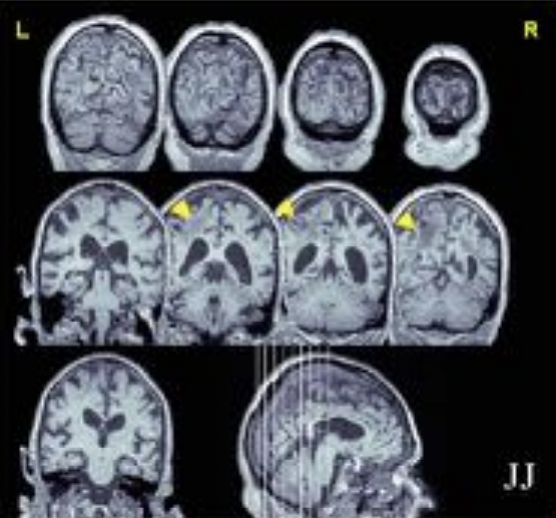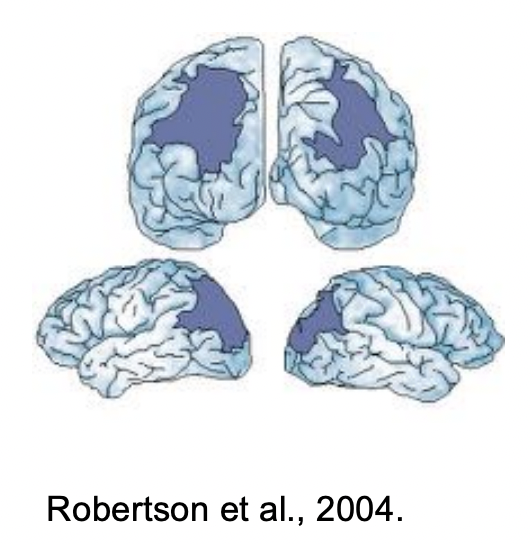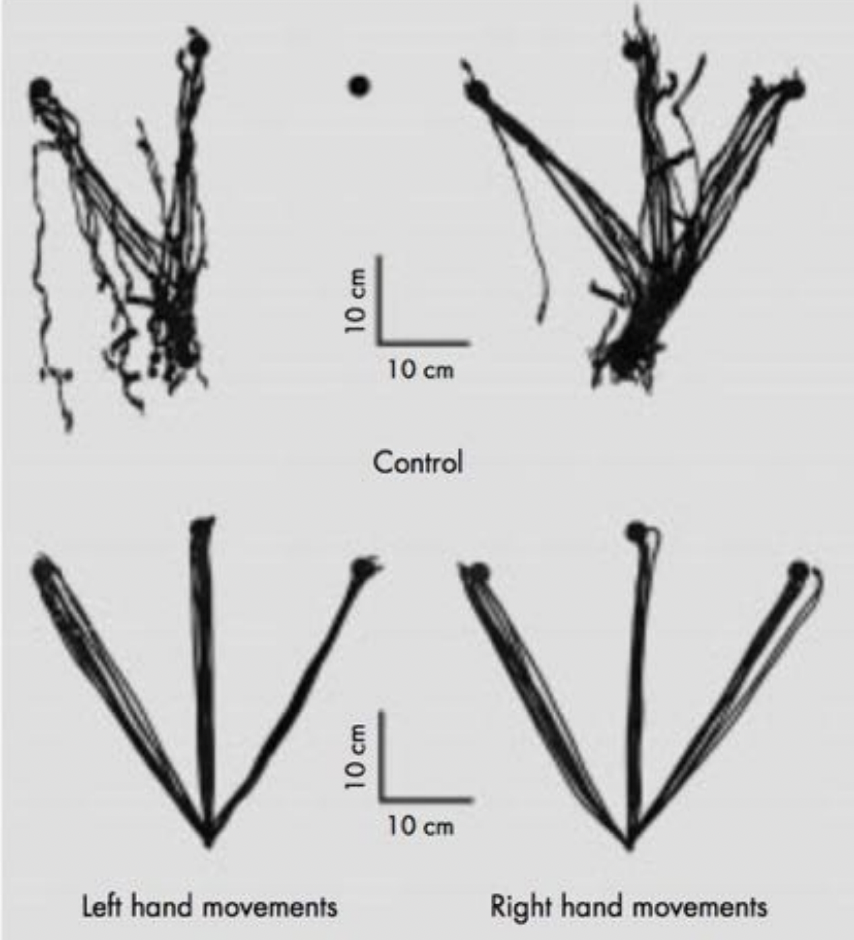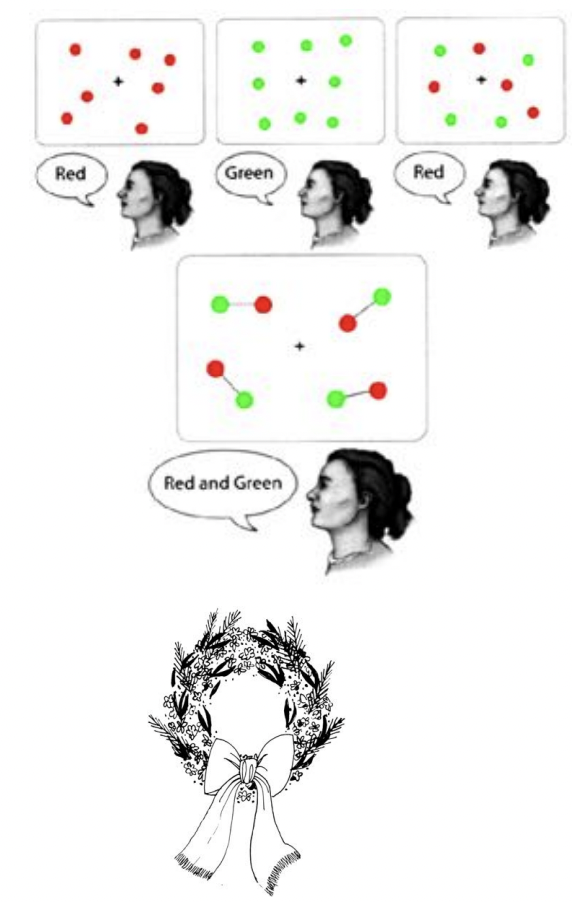
Chapter 4 Deficits in Spatial Attention PART 3
Balint’s Syndrome (1909)
A cluster of co-occuring visuomotor and visuospatial distrubances.
Balint’s syndrome results from bilateral damage to the posterior parietal lobes.
Patients with Balint’s syndrome may notice only one object at a time.
The triad of disorders associated with Balint’s syndrome are:
Simultanagnosia - inability to see the visual field as a whole
Ocular apraxia - deficit of visual scanning
Optic ataxia - inability to reach accurately under visual guidance
PATIENT #1

Description of a Balint’s patient (JJ): a 65-year-old man with a history of recurrent cerebral posterior hemorrhages affecting the occipital, parietal and temporal cortices of both cerebral hemispheres .
He frequently bumps into objects, unsure of where they are or not noticing them at all. He says, “I can see them but it is as if I can’t”. He complains of difficulty in finding objects and people around him. He has difficulty in performing everyday tasks. For example, he may misreach when trying to cut bread. Or he may unsuccessfully spend over an hour trying to wire an electric plug because he has difficulty in placing his fingers in the right place. When pouring tea, he may miss the cup entirely. He often fails to eat all the food on his plate because he does not see it, or knocks food off the plate with cutlery.
PATIENT #2

RM was unable to locate objects verbally, or by reaching or pointing.
In contrast, his basic visual abilities were normal (normal 20/15 visual acuity, normal colour vision, contrast sensitivity, etc.).
He was impaired at locating sounds too.
He was, however, able to state which parts of his body had been touched (e.g. left, right hand) and could follow commands to, say, touch his upper left arm with his right index finger
This suggests that spatial frames for the body had been preserved.
The opposite dissociation has been reported in another patient with parietal damage (although not with Balint's (Stark, Coslett, & Saffran, 1996)).
The brain appears to contain different mechanisms for computing body space and external space.

Top panel: abnormal pointing movements are shown from a patient with features of Bálint’s syndrome, in the context of the visual variant of Alzheimer’s disease.
The overhead view shows the paths of multiple pointing movements between a target directly in front of her body, in the midline, to more distal targets located to the left, middle, and right.
Multiple pointing movements are shown to each target with the left hand (left top panel) and right hand (right top panel). The patient made highly erratic movements (especially with the left hand).
Bottom panel: in comparison, a subject of similar age without neurological disease made smooth pointing movements.
The recordings were made using an optoelectronic technique to track infrared emitting diodes on the patient’s index finger.

FDG PET in the same patient with Bálint’s syndrome whose handpaths are depicted in previous figure
(A) Transverse view; (B) coronal view; (C) sagittal view.
The blue colour in all pictures indicates abnormally low cerebral activity, especially in the parietal regions.
Stimuli used to test object attention in Balint’s patients

Coloured circles were presented in two conditions: with and without connecting lines.
Bálint’s patients neglect entire objects, not just one side of an object as in hemispatial neglect, or parts of an object.
Simultanagnosia: is the inability to recognize two things at the same time, bilateral occipitotemporal dysfunction.
These patients would name wreath or bow in the figure, and not see/report the other.
Another factor that determines perceptual grouping of parts into wholes is the familiarity of the stimulus and how a given stimulus is interpreted (so-called top-down influence).
Shalev and Humphreys (2002) presented GK with the ambiguous stimuli.
When asked whether the two circles were at the top or bottom of the oval he was at chance (55%).
He preformed the task well (91%) when asked whether the eyes were at the top or bottom of the face.

Finally, it is a moot point as to whether these patients should be considered to have deficits of spatial attention or whether the medium of spatial representation itself has been lost.
These two ways of thinking are clearly related because spatial representations may be the medium over which attention operates, so without the former, there cannot be the latter.
Indeed, Balint's patients show an interesting parallel to inattention errors exhibited by normal participants.
n If a blue H and a green E are presented very quickly to normal participants then illusory conjunction errors are frequently reported (e.g. green H).
Balint’s patients show these errors even when they are free to view objects for as long as they like (e.g. Friedman-Hill et al., 1995).
This suggests that a spatial representation is not only needed to appreciate the spatial relationship between objects but also to support the kinds of processes needed to bind novel individual object features together.
Unilateral Visual Neglect
Unilateral Visual Neglect is often considered to be a more extreme version of attentional disorder .
Chapter 4 Deficits in Spatial Attention PART 3
Balint’s Syndrome (1909)
A cluster of co-occuring visuomotor and visuospatial distrubances.
Balint’s syndrome results from bilateral damage to the posterior parietal lobes.
Patients with Balint’s syndrome may notice only one object at a time.
The triad of disorders associated with Balint’s syndrome are:
Simultanagnosia - inability to see the visual field as a whole
Ocular apraxia - deficit of visual scanning
Optic ataxia - inability to reach accurately under visual guidance
PATIENT #1

Description of a Balint’s patient (JJ): a 65-year-old man with a history of recurrent cerebral posterior hemorrhages affecting the occipital, parietal and temporal cortices of both cerebral hemispheres .
He frequently bumps into objects, unsure of where they are or not noticing them at all. He says, “I can see them but it is as if I can’t”. He complains of difficulty in finding objects and people around him. He has difficulty in performing everyday tasks. For example, he may misreach when trying to cut bread. Or he may unsuccessfully spend over an hour trying to wire an electric plug because he has difficulty in placing his fingers in the right place. When pouring tea, he may miss the cup entirely. He often fails to eat all the food on his plate because he does not see it, or knocks food off the plate with cutlery.
PATIENT #2

RM was unable to locate objects verbally, or by reaching or pointing.
In contrast, his basic visual abilities were normal (normal 20/15 visual acuity, normal colour vision, contrast sensitivity, etc.).
He was impaired at locating sounds too.
He was, however, able to state which parts of his body had been touched (e.g. left, right hand) and could follow commands to, say, touch his upper left arm with his right index finger
This suggests that spatial frames for the body had been preserved.
The opposite dissociation has been reported in another patient with parietal damage (although not with Balint's (Stark, Coslett, & Saffran, 1996)).
The brain appears to contain different mechanisms for computing body space and external space.

Top panel: abnormal pointing movements are shown from a patient with features of Bálint’s syndrome, in the context of the visual variant of Alzheimer’s disease.
The overhead view shows the paths of multiple pointing movements between a target directly in front of her body, in the midline, to more distal targets located to the left, middle, and right.
Multiple pointing movements are shown to each target with the left hand (left top panel) and right hand (right top panel). The patient made highly erratic movements (especially with the left hand).
Bottom panel: in comparison, a subject of similar age without neurological disease made smooth pointing movements.
The recordings were made using an optoelectronic technique to track infrared emitting diodes on the patient’s index finger.

FDG PET in the same patient with Bálint’s syndrome whose handpaths are depicted in previous figure
(A) Transverse view; (B) coronal view; (C) sagittal view.
The blue colour in all pictures indicates abnormally low cerebral activity, especially in the parietal regions.
Stimuli used to test object attention in Balint’s patients

Coloured circles were presented in two conditions: with and without connecting lines.
Bálint’s patients neglect entire objects, not just one side of an object as in hemispatial neglect, or parts of an object.
Simultanagnosia: is the inability to recognize two things at the same time, bilateral occipitotemporal dysfunction.
These patients would name wreath or bow in the figure, and not see/report the other.
Another factor that determines perceptual grouping of parts into wholes is the familiarity of the stimulus and how a given stimulus is interpreted (so-called top-down influence).
Shalev and Humphreys (2002) presented GK with the ambiguous stimuli.
When asked whether the two circles were at the top or bottom of the oval he was at chance (55%).
He preformed the task well (91%) when asked whether the eyes were at the top or bottom of the face.

Finally, it is a moot point as to whether these patients should be considered to have deficits of spatial attention or whether the medium of spatial representation itself has been lost.
These two ways of thinking are clearly related because spatial representations may be the medium over which attention operates, so without the former, there cannot be the latter.
Indeed, Balint's patients show an interesting parallel to inattention errors exhibited by normal participants.
n If a blue H and a green E are presented very quickly to normal participants then illusory conjunction errors are frequently reported (e.g. green H).
Balint’s patients show these errors even when they are free to view objects for as long as they like (e.g. Friedman-Hill et al., 1995).
This suggests that a spatial representation is not only needed to appreciate the spatial relationship between objects but also to support the kinds of processes needed to bind novel individual object features together.
Unilateral Visual Neglect
Unilateral Visual Neglect is often considered to be a more extreme version of attentional disorder .